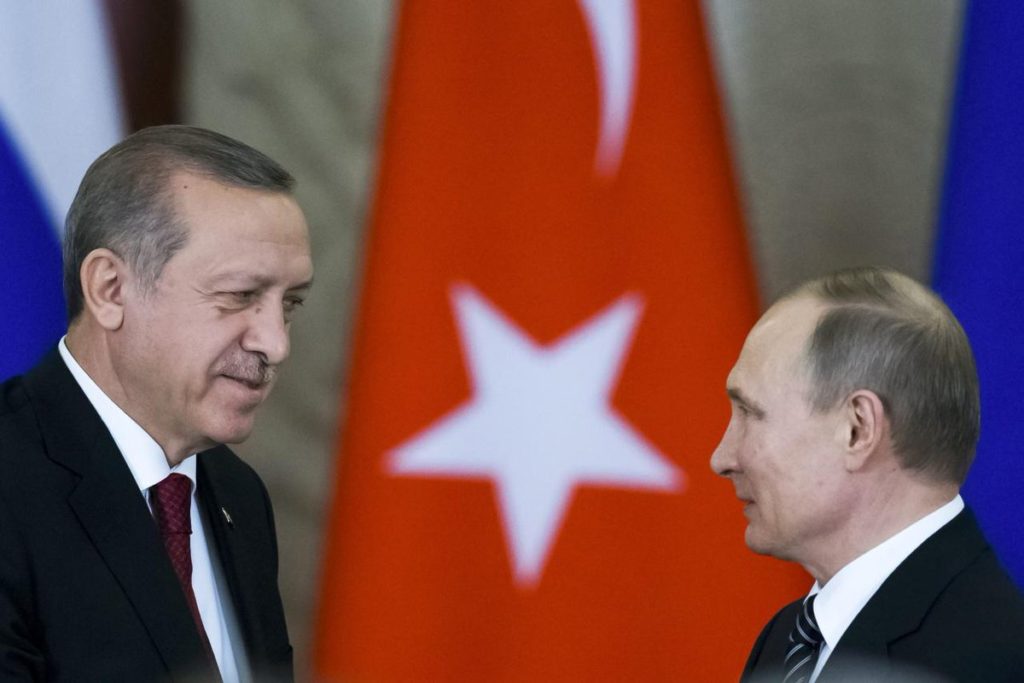
Russia officially opened its TurkStream natural gas pipeline on Wednesday, further diversifying export routes to Europe amid a backlash from the U.S.
President Vladimir Putin and his Turkish counterpart Recep Tayyip Erdogan met in Istanbul to inaugurate the pipeline in a ceremony celebrating the nations’ energy and political ties. TurkStream is set to carry Russian gas under the Black Sea to Turkey and supply several countries in southeastern Europe once fully operational, just as U.S. sanctions stall another Gazprom PJSC export line.
TurkStream consists of two pipelines running together underwater, each with an annual capacity of 15.75 billion cubic meters. Gas via the link has been flowing to Turkey and Bulgaria since Jan. 1, according to utility Bulgargaz. A combination of existing and new pipelines will subsequently take supplies to Serbia and later on to Hungary.
The project allows Russian producer Gazprom to achieve two strategic aims. First, it may help the company increase its market share in Turkey, currently among the top three buyers of its gas. Second, Gazprom can reduce its dependence on Ukraine as a transit route, a key objective following years of strained political relations between the two neighbours.
Construction of another major Russian pipeline project — the Nord Stream 2 link under the Baltic Sea — was halted last month because of American sanctions on the contractors building the line to Germany. The U.S., itself an emerging gas exporter to Europe, has claimed that Gazprom’s pipeline projects hurt the region’s security of supply.
Nevertheless, Putin insisted that the start of TurkStream “is important not only for Russia and Turkey, but also for the countries of southern Europe, for the whole European continent.”
For Russia, the inauguration marks a further success in adding export routes, despite Nord Stream 2’s setback. Gazprom last month opened the giant Power of Siberia gas pipeline, which runs from Russia’s enormous reserves in eastern Siberia to northern China.
Ukraine reliance
Until now, Russian gas flows to Turkey have been split almost evenly between supplies via Ukraine and direct shipments via the Blue Stream link, completed 16 years ago.
With the start of the new pipeline, as much as 13 billion cubic meters of Russian gas can be immediately diverted from the Ukrainian transit route into the first line of TurkStream for Turkish consumption, the Oxford Institute for Energy Studies said in October.
TurkStream “will significantly increase global energy stability,” Russian Energy Minister Alexander Novak said Wednesday at the ceremony. Russia has shown itself to be a reliable supplier, with “colossal” gas resources, he said.
Bulgaria has prepared its gas grid to accommodate about 2.9 billion cubic meters of the fuel from TurkStream, while Serbia expects to receive an initial supply of more than 3 billion cubic meters a year, according to state-owned gas company Srbijagas. Serbia will also be able to transit as much as 6 billion cubic meters a year to Hungary via an interconnector that’s projected to come online in 2021.
Bulgarian Prime Minister Boyko Borissov joined the leaders of Russia, Turkey and Serbia to turn on a symbolic red tap, officially opening the new gas link.